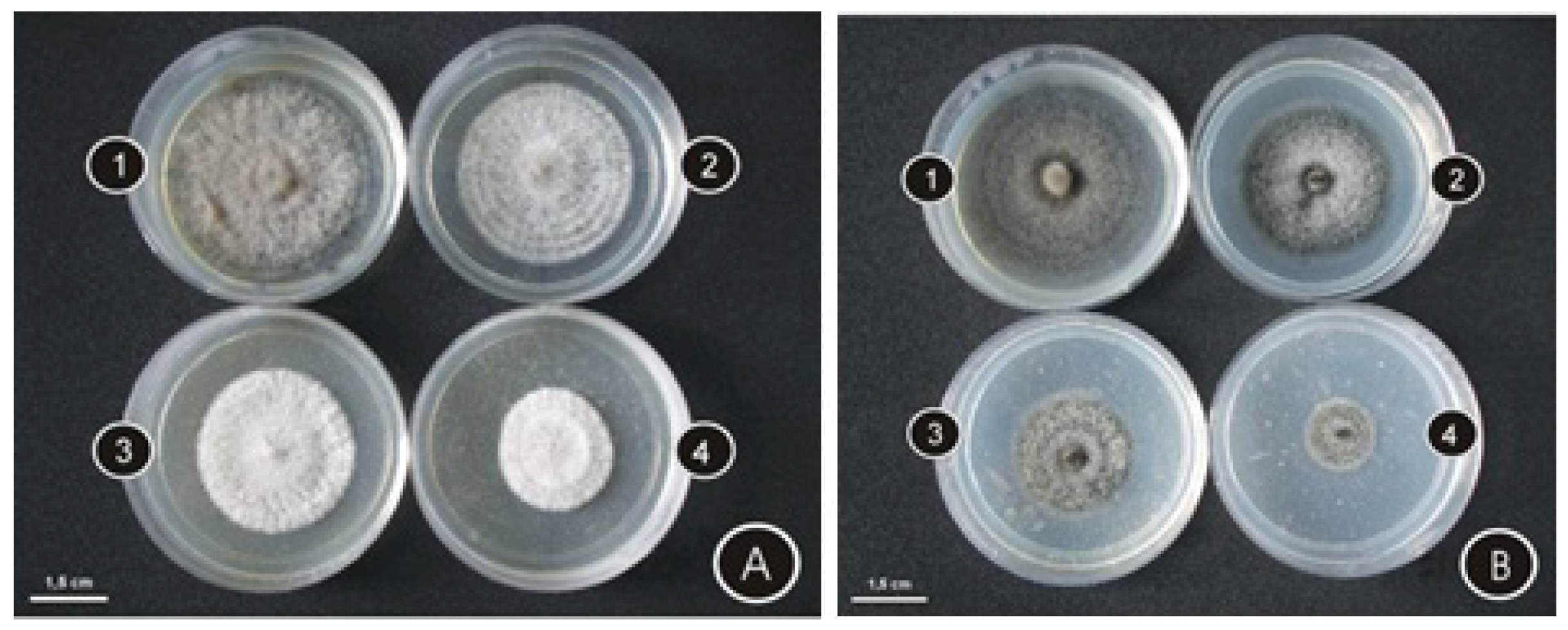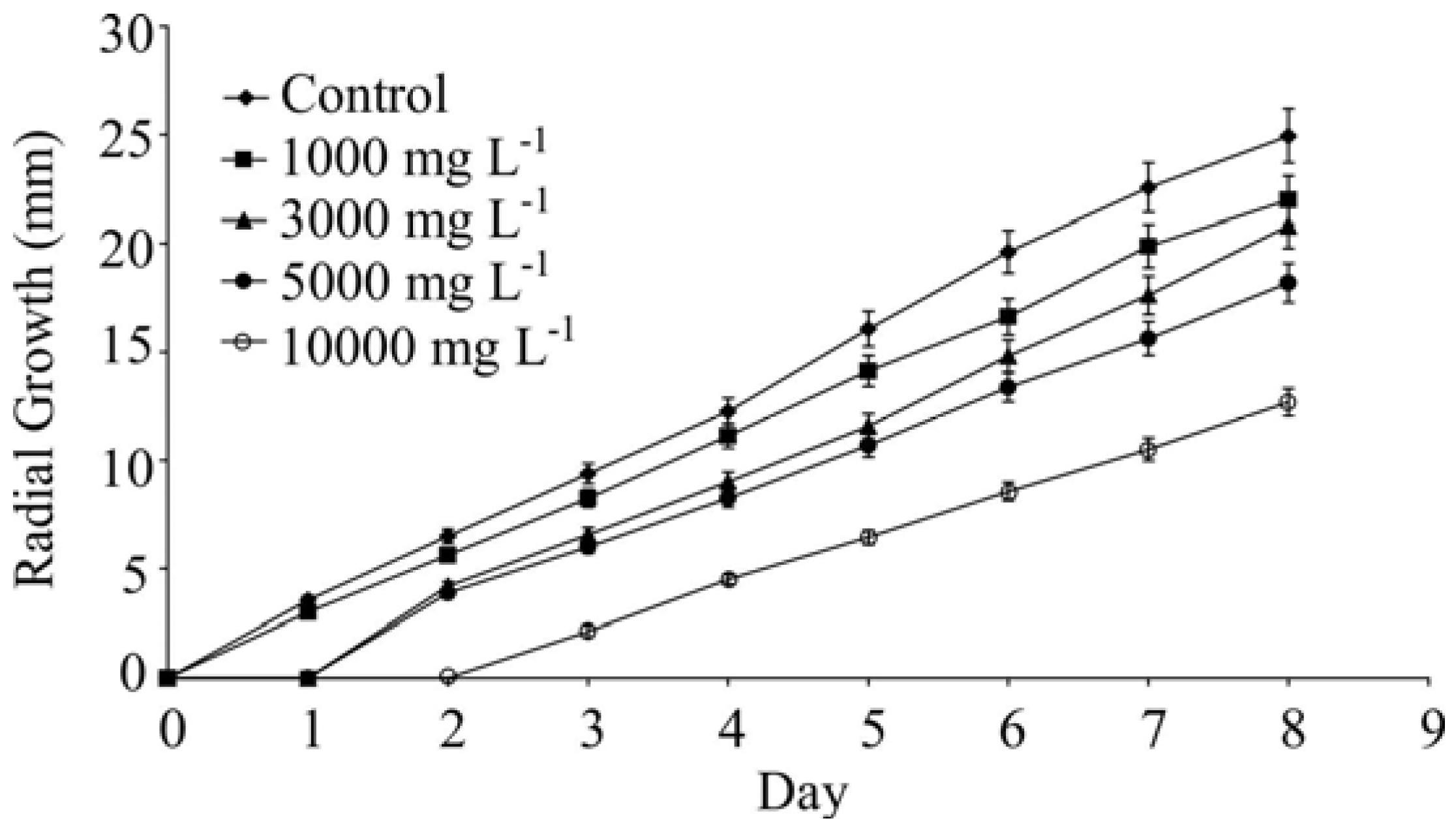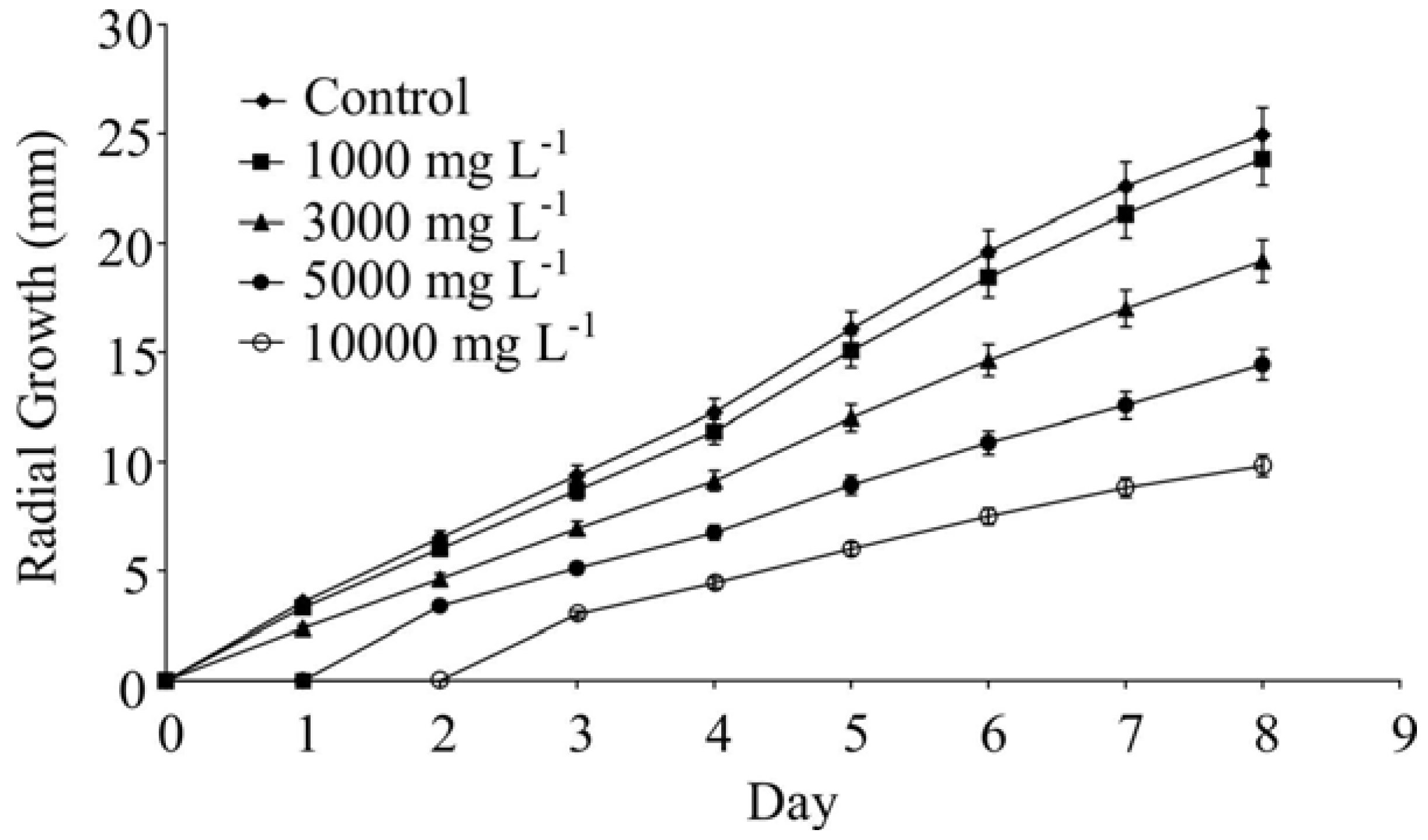Chemical Characterization of Volatile Compounds of Lantana camara L. and L. radula Sw. and Their Antifungal Activity
Abstract
:1. Introduction
2. Results and Discussion
2.1. Volatile Oils
| Peak no. | Constituent a | RI | L. camara (%) | L. radula (%) |
|---|---|---|---|---|
| 1 | α-Copaene | 1374 | 1.1 ± 0.12 | - |
| 2 | β-Elemene | 1390 | 3.2 ± 0.51 | - |
| 3 | Tetradecane | 1399 | 1.0 ± 0.55 | 1.8 ± 0.26 |
| 4 | E-Caryophyllene | 1418 | 19.7 ± 3.32 | 25.3 ± 5.47 |
| 5 | β-Gurjunene | 1427 | 1.2 ± 0.15 | - |
| 6 | α-Humulene | 1451 | 9.3 ± 0.30 | 1.2 ± 0.06 |
| 7 | β- E-Farnesene | 1458 | 1.3 ± 0.20 | Tr |
| 8 | Germacrene-D | 1479 | 19.8 ± 1.40 | 17.6 ± 1.21 |
| 9 | Bicyclogermacrene | 1493 | 11.7 ± 0.67 | 4.0 ± 0.10 |
| 10 | α-Muurolene | 1498 | 1.5 ± 0.15 | - |
| 11 | Germacrene-A | 1501 | 2.5 ± 0.36 | - |
| 12 | Cubeol | 1511 | 2.5 ± 1.14 | - |
| 13 | δ-Cadinene | 1520 | 2.4 ± 0.35 | - |
| 14 | E-Nerolidol | 1562 | - | 19.0 ± 3.56 |
| 15 | Germacrene-D-4-ol | 1567 | 1.2 ± 0.30 | - |
| 16 | Caryophyllene oxide | 1579 | - | 1.7 ± 0.67 |
| 17 | Davanone | 1572 | 1.2 ± 0.58 | - |
| 18 | Globulol | 1581 | 0.7 ± 0.40 | - |
| 19 | Humuladyenone * | 1594 | 1.2 ± 0.36 | - |
| 20 | Epi-α-Muurolol | 1638 | 4.8 ± 0.32 | - |
| 21 | Phytol | 2092 | 4.0 ± 1.45 | 29.2 ± 5.23 |
| Identified (%) | 86.3 | 99.8 |
2.2. Bioassay



3. Experimental
3.1. Plant Material
3.2. Extraction and Analysis of the Essential Oils
3.3. Essential Oil Gas Chromatography-Mass Spectrometry (GC-MS) Chemical Analysis
3.4. Effect of Volatile Oils on Mycelial Growth of C. Cassiicola
4. Conclusions
Acknowledgments
References
- Fahn, A. Secretory Tissues in Plants; Academic Press: London, UK, 1979. [Google Scholar]
- Metcalfe, C.R.; Chalk, L. Anatomy of the Dicotyledons: Leaves, Stem and Wood in Relation to Taxonomy with Notes on Economic Uses; Clarendon Press: Oxford, UK, 1950. [Google Scholar]
- Gottlieb, O.R.; Salatino, A. Funções e evolução dos óleos essenciais e de suas estruturas secretoras (In Portuguese). Ciên. Cultura 1987, 39, 707–716. [Google Scholar]
- Combrinck, S.; Du Plooy, G.W.D.; McCrindle, R.I.; Botha, B.M. Morphology and histochemistry glandular trichomes of Lippia scaberrima (Verbenaceae). Ann. Bot. 2007, 99, 1111–1119. [Google Scholar] [CrossRef]
- Werker, E. Function of essential oil-secreting glandular hairs in aromatic plants of the Lamiaceae—A review. Flavour. Fragr. J. 1993, 8, 249–255. [Google Scholar] [CrossRef]
- Alitonou, G.; Avlessi, F.; Bokossa, I.; Ahoussi, E.; Dangou, J.; Sohounhloué, D.C.K. Composition chimique et activités biologiques de l'huile essentielle de Lantana camara Linn. Comptes Rendus Chime 2004, 7, 1101–1105. [Google Scholar] [CrossRef]
- Paré, P.W.; Tumlinson, J.H. Plant volatiles as a defense against insect herbivores. Plant Physiol. 1999, 121, 325–332. [Google Scholar] [CrossRef]
- Pichersky, E.; Gershenzon, J. The formation and function of plant volatiles: Perfumes for pollinator attraction and defense. Curr. Opin. Plant Biol. 2002, 5, 237–243. [Google Scholar] [CrossRef]
- Randrianalijaona, J.; Ramanoelina, P.A.R.; Rasoarahona, J.R.E.; Gaydou, E.M. Seasonal and chemotype influences on the chemical composition of Lantana camara L.: Essential oils from Madagascar. Anal. Chim. Acta 2005, 545, 46–52. [Google Scholar]
- Moura, M.Z.D.; Isaias, R.M.S.; Soares, G.L.G. Ontogenesis of internal secretory cells in leaves of Lantana camara (Verbenaceae). Bot. J. Linn. Soc. 2005, 148, 427–431. [Google Scholar] [CrossRef]
- Day, M.D.; Willey, C.J.; Playford, J.; Zalucki, M.P. Lantana: Current Management Status and Future Prospects; Australian Centre for International Agricultural Research: Canberra, Australian, 2003. [Google Scholar]
- Silva, W.P.K.; Deverall, B.J.; Lyon, B.R. Molecular, physiological and pathological characterization of Corynespora leaf spot fungi rubber plantations in Sri Lanka. Plant Pathol. 1998, 47, 267–277. [Google Scholar] [CrossRef]
- Pereira, J.M.; Barreto, R.W.; Ellison, C.A.; Maffia, L.A. Corynespora cassiicola f. sp. lantanae: A potential biocontrol agent from Brazil for Lantana camara. Biol. Control 2003, 26, 21–31. [Google Scholar]
- Passos, J.L.; Barbosa, L.C.A.; Demuner, A.J.; King-Diaz, B.; Lotina-Hennsen, B. Effects of Corynespora cassiicola on Lantana camara. Planta Daninha 2010, 28, 229–237. [Google Scholar]
- Deena, M.J.; Thoppil, J.E. Antimicrobial activity of the essential oil of Lantana camara. Fitoterapia 2000, 71, 453–455. [Google Scholar] [CrossRef]
- Hernandez, T.; Canales, M.; Ávila, J.G.; Garcıa, A.M. Composition and antibacterial activity of essential oil of Lantana achyranthifolia Desf. (Verbenaceae). J. Ethnopharm. 2005, 96, 551–544. [Google Scholar]
- Verdeguer, M.; Blazquez, M.A.; Boira, H. Phytotoxic effects of Lantana camara, Eucalyptus camaldulensis and Eriocephalus africanus essential oils in weeds of Mediterranean summer crops. Biochem. Syst. Ecol. 2009, 37, 362–369. [Google Scholar] [CrossRef]
- Moura, M.Z.D.; Soares, G.L.G.; Isaias, R.M.S. Species-specific changes in tissue morphogenesis induced by two arthropod leaf gallers in Lantana camara L. (Verbenaceae). Aust. J. Bot. 2008, 56, 153–160. [Google Scholar]
- Passos, J.L.; Meira, R.M.S.A.; Barbosa, L.C.A.; Barreto, R.W. Foliar anatomy of the species Lantana camara and L. radula (Verbenaceae). Planta Daninha 2009, 27, 689. [Google Scholar]
- Ascensão, L.; Mota, L.; Castro, M.M. Glandular trichomes on the leaves and flowers of Plectranthus ornatus: morphology, distribution and histochemistry. Ann. Bot. 1999, 84, 437–447. [Google Scholar] [CrossRef]
- Misra, L.; Laatsch, H. Triterpenoids, essential oil and photo-oxidative 28-13-lactonization of oleanolic acid from Lantana camara. Phytochemistry 2000, 54, 969–974. [Google Scholar] [CrossRef]
- Andrade, E.H.A.; Zoghbi, M.G.B.; Luz, A.I.R.; Silva, J.D.; Maia, J.G.S. The essential oils of Lantana camara L. occurring in North Brazil. Flav. Fragr. J. 1999, 14, 208–210. [Google Scholar] [CrossRef]
- Barbosa, L.C.A.; Demuner, A.J.; Teixeira, R.R.; Madruga, M.S. Chemical constituents of the bark of Gallesia gorazema. Fitoterapia 1999, 70, 152–156. [Google Scholar] [CrossRef]
- Barbosa, L.C.A.; Demuner, A.J.; Maltha, C.R.A.; Silva, P.S.; Silva, A.A. Sintese e avaliação da atividade fitotóxica de novos análogos oxigenados do ácido helmintospórico (in Portuguese). Quím. Nova 2003, 26, 655–660. [Google Scholar]
- Barbosa, L.C.A.; Paula, V.F.; Azevedo, A.S.; Silva, E.A.M.; Nascimento, E.A. Essential oil composition from some plant parts of Conyza bonariensis (L.) Cronquist. Flav. Fragr. J. 2005, 20, 39–45. [Google Scholar] [CrossRef]
- Martins, E.R.; Casali, V.W.D.; Barbosa, L.C.A.; Carazza, F. Essential oil in the taxonomy of Ocimum selloi Benth. J. Braz. Chem. Soc. 1997, 8, 29–32. [Google Scholar]
- Silva, M.H.L.; Silva, A.F.; Barbosa, L.C.A.; Nascimento, E.A.; Casali, V.W.D. Chemical composition of the essential oil of Hyptis glomerata mart. ex Schrank (Lamiaceae). J. Essent. Oil. Res. 2000, 12, 725–727. [Google Scholar] [CrossRef]
- Barbosa, L.C.A.; Demuner, A.J.; Dumont, A.C.; Paula, V.F.; Ismail, F.M.D. Seasonal variation in the composition of volatile oils from Schinus terebinthifolius Raddi. Quím. Nova 2007, 30, 1959–1965. [Google Scholar] [CrossRef]
- Martins, F.T.; Santos, M.H.; Polo, M.; Barbosa, L.C.A. Variação química do óleo essencial de Hyptis suaveolens (L.) Poit, sob condições de cultivo (in Portuguese). Quím. Nova 2006, 29, 1203–1209. [Google Scholar] [CrossRef]
- Martins, F.T.; Santos, M.H.; Polo, M.; Barbosa, L.C.A. Effects of the interactions among macronutrients, plant age and photoperiod in the composition of Hyptis suaveolens (L.) Poit essential oil from Alfenas (MG), Brazil. Flav. Fragr. J. 2007, 22, 123–127. [Google Scholar] [CrossRef]
- Carvalho, M.R.; Barbosa, L.C.A.; Queiroz, J.H.; Howarth, O.W. Novel Lactones from Aspergillus versicolor. Tetrahedron Lett. 2001, 42, 809–810. [Google Scholar]
- Demuner, A.J.; Barbosa, L.C.A.; Veiga, T.A.M.; Barreto, R.W.; King-Diaz, B.; Henssen, B.L. Phytotoxic constituents from Nimbya alternantherae. Biochem. Syst. Ecol. 2006, 34, 790–795. [Google Scholar] [CrossRef]
- Nascimento, J.C.; Barbosa, L.C.A.; Paula, V.F.; David, J.M.; Fontana, R.; Silva, L.A.M.; França, R.S. Chemical Composition and antimicrobial activity of essential oils of Ocimum canum Sims. and Ocimum selloi Benth. An. Acad. Bras. Ciências 2011, 83, 787–799. [Google Scholar] [CrossRef]
- Montanari, R.M.; Barbosa, L.C.A.; Demuner, A.J.; Silva, C.J.; Carvalho, L.S.; Andrade, N.J. Chemical composition and antibacterial activity of essential oils from Verbenaceae species: Alternative sources of (E)-caryophyllene and germacrene-D. Química Nova 2011, 34, 1550–1555. [Google Scholar] [CrossRef]
- Demuner, A.J.; Barbosa, L.C.A.; Gonçalves, M.C.; Silva, C.J.; Maltha, C.R.A.; Pinheiro, A.L. Seasonal variation in the chemical composition and antimicrobial activity of volatile oils of three species of Leptospermum (myrtaceae) grown in Brazil. Molecules 2011, 16, 1181–1191. [Google Scholar] [CrossRef]
- Castro, H.G.; Oliveira, L.O.; Barbosa, L.C.A.; Ferreira, F.A.; Silva, D.J.H.; Mosquim, P.R.; Nascimento, E.A. Teor e composição do óleo essencial de cinco acessos de mentrasto (in Portuguese). Quím. Nova 2004, 27, 55–57. [Google Scholar] [CrossRef]
- Roussis, V.; Chinou, I.B.; Tsitsimpikou, C.; Vagias, C.; Petrakis, P.V. Antibacterial activity of volatile secondary metabolites from caribbean soft corals of the genus Gorgonia. Flavour Fragr. J. 2001, 16, 364–366. [Google Scholar] [CrossRef]
- Marques, A.M.; Barreto, A.L.; Batista, E.M.; Curvelo, J.A.; Velozo, L.S.; Moreira, D.L.; Guimarães, E.F.; Soares, R.M.; Kaplan, M.A. Chemistry and biological activity of essential oils from Piper claussenianum (Piperaceae). Nat. Prod. Commun. 2010, 5, 1837–1840. [Google Scholar]
- Cheng, S.S.; Liu, J.K.; Hsui, Y.R.; Chang, S.T. Chemical polymorphism and antifungal activity of essential oils from leaves of different provenances of indigenous cinnamon (Cinnamomum osmophloeum). Bioresour. Technol. 2006, 97, 306–312. [Google Scholar] [CrossRef]
- Standards Engineering Practices Data, Moisture Measurement-Forages, ASAE S358.2 DEC99; American Society of Agricultural Engineers: St. Joseph, MS, USA, 2000.
- Adams, R.P. Identification of Essential Oil Components by Gas Chromatography/Mass Spectroscopy; Allured Publishing Corporation: Carol Stream, IL, USA, 1995. [Google Scholar]
- Dhingra, O.D. Sinclair, J.B.; Sinclair, J.B. Basic Plant Pathology Methods, 2nd ed.; Lewis Publishers: London, UK, 1995. [Google Scholar]
- Sample Availability: Samples of the essential oils are available from the authors.
© 2012 by the authors; licensee MDPI, Basel, Switzerland. This article is an open-access article distributed under the terms and conditions of the Creative Commons Attribution license (http://creativecommons.org/licenses/by/3.0/).
Share and Cite
Passos, J.L.; Barbosa, L.C.A.; Demuner, A.J.; Alvarenga, E.S.; Silva, C.M.d.; Barreto, R.W. Chemical Characterization of Volatile Compounds of Lantana camara L. and L. radula Sw. and Their Antifungal Activity. Molecules 2012, 17, 11447-11455. https://doi.org/10.3390/molecules171011447
Passos JL, Barbosa LCA, Demuner AJ, Alvarenga ES, Silva CMd, Barreto RW. Chemical Characterization of Volatile Compounds of Lantana camara L. and L. radula Sw. and Their Antifungal Activity. Molecules. 2012; 17(10):11447-11455. https://doi.org/10.3390/molecules171011447
Chicago/Turabian StylePassos, Juliana Lanna, Luiz Claudio Almeida Barbosa, Antonio Jacinto Demuner, Elson Santiago Alvarenga, Cleiton Moreira da Silva, and Robert Weingart Barreto. 2012. "Chemical Characterization of Volatile Compounds of Lantana camara L. and L. radula Sw. and Their Antifungal Activity" Molecules 17, no. 10: 11447-11455. https://doi.org/10.3390/molecules171011447




